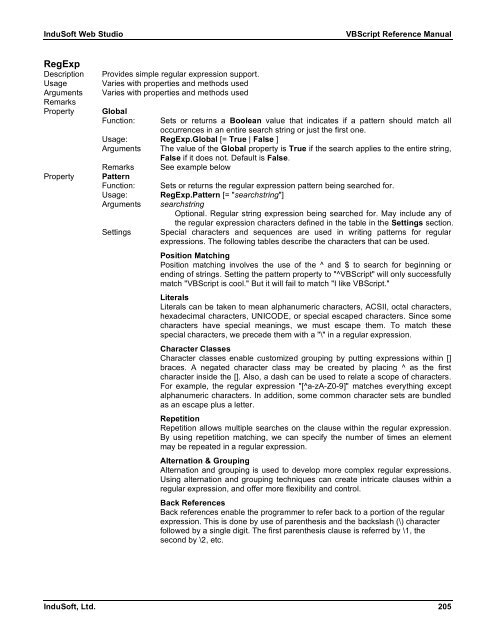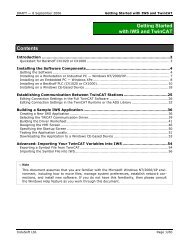VBScript Reference Manual for InduSoft Web Studio
VBScript Reference Manual for InduSoft Web Studio
VBScript Reference Manual for InduSoft Web Studio
Create successful ePaper yourself
Turn your PDF publications into a flip-book with our unique Google optimized e-Paper software.
<strong>InduSoft</strong> <strong>Web</strong> <strong>Studio</strong> <strong>VBScript</strong> <strong>Reference</strong> <strong>Manual</strong><br />
RegExp<br />
Description Provides simple regular expression support.<br />
Usage Varies with properties and methods used<br />
Arguments Varies with properties and methods used<br />
Remarks<br />
Property Global<br />
Function: Sets or returns a Boolean value that indicates if a pattern should match all<br />
occurrences in an entire search string or just the first one.<br />
Usage: RegExp.Global [= True | False ]<br />
Arguments The value of the Global property is True if the search applies to the entire string,<br />
False if it does not. Default is False.<br />
Remarks See example below<br />
Property Pattern<br />
Function: Sets or returns the regular expression pattern being searched <strong>for</strong>.<br />
Usage: RegExp.Pattern [= "searchstring"]<br />
Arguments searchstring<br />
Optional. Regular string expression being searched <strong>for</strong>. May include any of<br />
the regular expression characters defined in the table in the Settings section.<br />
Settings Special characters and sequences are used in writing patterns <strong>for</strong> regular<br />
expressions. The following tables describe the characters that can be used.<br />
Position Matching<br />
Position matching involves the use of the ^ and $ to search <strong>for</strong> beginning or<br />
ending of strings. Setting the pattern property to "^<strong>VBScript</strong>" will only successfully<br />
match "<strong>VBScript</strong> is cool." But it will fail to match "I like <strong>VBScript</strong>."<br />
Literals<br />
Literals can be taken to mean alphanumeric characters, ACSII, octal characters,<br />
hexadecimal characters, UNICODE, or special escaped characters. Since some<br />
characters have special meanings, we must escape them. To match these<br />
special characters, we precede them with a "\" in a regular expression.<br />
Character Classes<br />
Character classes enable customized grouping by putting expressions within []<br />
braces. A negated character class may be created by placing ^ as the first<br />
character inside the []. Also, a dash can be used to relate a scope of characters.<br />
For example, the regular expression "[^a-zA-Z0-9]" matches everything except<br />
alphanumeric characters. In addition, some common character sets are bundled<br />
as an escape plus a letter.<br />
Repetition<br />
Repetition allows multiple searches on the clause within the regular expression.<br />
By using repetition matching, we can specify the number of times an element<br />
may be repeated in a regular expression.<br />
Alternation & Grouping<br />
Alternation and grouping is used to develop more complex regular expressions.<br />
Using alternation and grouping techniques can create intricate clauses within a<br />
regular expression, and offer more flexibility and control.<br />
Back <strong>Reference</strong>s<br />
Back references enable the programmer to refer back to a portion of the regular<br />
expression. This is done by use of parenthesis and the backslash (\) character<br />
followed by a single digit. The first parenthesis clause is referred by \1, the<br />
second by \2, etc.<br />
<strong>InduSoft</strong>, Ltd. 205



